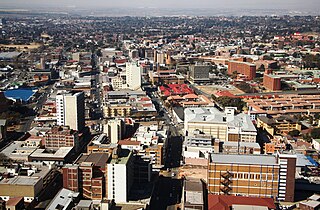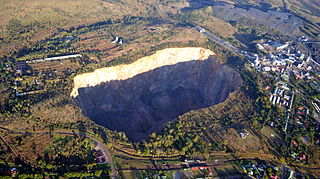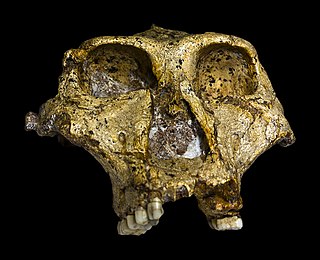 W
WThe paleoanthropological site self-proclaimed as the Cradle of Humankind is located about 50 km (31 mi) northwest of Johannesburg, South Africa, in the Gauteng province. Declared a World Heritage site by UNESCO in 1999, the site currently occupies 47,000 hectares (180 sq mi) and contains a complex of limestone caves. The registered name of the site in the list of World Heritage sites is Fossil Hominid Sites of South Africa.
 W
WThe Drimolen Palaeocave System consists of a series of a terminal Pliocene to early Pleistocene hominin-bearing palaeocave fills located around 40 kilometres (25 mi) north of Johannesburg, South Africa, and about 6 kilometres (3.7 mi) north of Sterkfontein in the UNESCO World Heritage Site Cradle of Humankind.
 W
WThe East Rand is the urban eastern part of the Witwatersrand that is functionally merged with the Johannesburg conurbation in South Africa. This area became settled by Europeans after a gold-bearing reef was discovered in 1886 and sparked the gold rush that gave rise to the establishment of Johannesburg.
 W
WThe Premier Mine is an underground diamond mine owned by Petra Diamonds in the town of Cullinan, 40 kilometres (25 mi) east of Pretoria, Gauteng Province, South Africa. Established in 1902, it was renamed the Cullinan Diamond Mine in November 2003 in celebration of its centenary. The mine rose to prominence in 1905, when the Cullinan Diamond – the largest rough diamond of gem quality ever found – was discovered there. The mine has produced over 750 stones that are greater than 100 carats (20 g) and more than a quarter of all the world's diamonds that are greater than 400 carats (80 g). It is also the only significant source of blue diamonds in the world.
 W
WSwartkrans is a fossil-bearing cave designated as a South African National Heritage Site, located about 32 km (20 mi) from Johannesburg. It is located in the Cradle of Humankind World Heritage Site and is notable for being extremely rich in archaeological material, particularly hominin remains. Fossils discovered in the limestone of Swartkrans include Homo ergaster, Paranthropus and Homo habilis. The oldest deposits present at the site are believed to be between 1.9 and 2.1 million years old.
 W
WThe Vaal Triangle is a triangular area formed by Vereeniging, Vanderbijlpark and Sasolburg about 60km south of Johannesburg, South Africa. The area forms a substantial urban complex. Meyerton, just north of Vereeniging, is also generally included in the complex, and residents of Sharpeville, Boipatong, Bophelong, the greater Sebokeng area, Heidelberg, Zamdela, Deneysville and Potchefstroom also generally tend to consider themselves to live in the Vaal Triangle. The area straddles the Vaal River and is a major industrial region, which is home to former Iron and Steel Corporation Iscor, now ArcelorMittal South Africa, and Sasol, the steel and petrochemical processing facilities.
 W
WWest Rand is the name of the urban western part of the Witwatersrand that is functionally merged with the Johannesburg conurbation. This area became settled by Europeans after a gold-bearing reef discovered in 1886 and sparked the gold rush that gave rise to the establishment of Johannesburg.